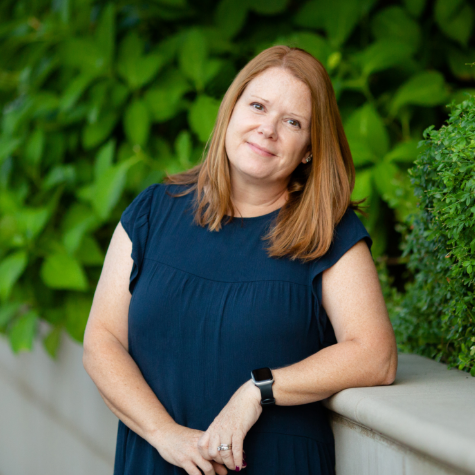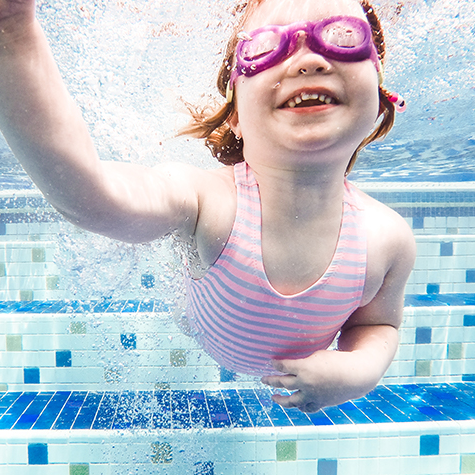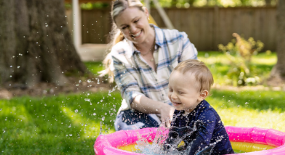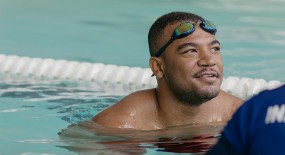Season 1: Episode 1
Hope and Will: A Parenting Podcast from Children's Healthcare of Atlanta
It Only Took 30 Seconds: How One Attentive Mom Almost Lost Her Daughter to Drowning
It only takes 30 seconds. That’s what Melissa Gibson learned when her toddler disappeared from the couch, only to be found moments later, floating face down in the swimming pool. Thanks to a perfect concert of miracles, Josie’s story has a happy ending. Now, our own pediatric emergency medicine physician, Dr. Sarah Lazarus, and the Gibson family are teaming up to share their experience and insight to empower you to keep kids—from infants to teens—safe around water.

Dr. Sarah Lazarus, Pediatric Emergency Medicine Physician
Sarah Lazarus, DO, is a pediatric emergency medicine physician at Children's Healthcare of Atlanta, and a mom to twin boys. She is on the Executive Committee for the Children's Injury Prevention Program at Children's and runs the "Save Babies" task force.

Melissa Gibson
Melissa Gibson is a photographer, writer and mother of four. Following the near-fatal drowning of her 2-year-old in 2018, Melissa and her family have become impassioned advocates for water safety, sharing their story via media and local speaking engagements.

Lynn Smith
Lynn Smith is a veteran journalist, podcast host and mom of two boys. Her experience as the parent of a patient at Children’s inspired her to advocate for spreading awareness of childhood illnesses and injuries.

You are your child’s lifeguard
Always keep younger, beginner swimmers within arm’s reach around water. And always keep older, more confident swimmers within eye’s reach.
read her storyWater Safety tips from Strong4Life
Lynn: As a pediatric emergency room doctor, Sarah Lazarus has shared unthinkable news with parents and it never gets easier. What really keeps her up at night is seeing kids who've suffered preventable injuries. Injuries like drownings, which is something Josie's family experienced firsthand back in 2018.
Today, we’ll be speaking with Melissa, a mom whose life was changed forever when she found her daughter floating face down in a pool, and Dr. Lazarus. Melissa is one of the lucky ones—her story has a happy ending. Together, they're teaming up to remind you that the season for water safety vigilance is every month of the year. Melissa, take me back to when you realized that in seconds of not having your eyes on your little girl, it meant that she drowned.
Melissa: We were at my father-in-law's birthday party, and he has a pool. My husband and I have three older girls, and at the time they were like little mommies to her, so we had eyes everywhere on her. She had on a puddle jumper and after about two hours in the pool, we went inside to watch a movie. I took off Josie’s puddle jumper and I said to her, “Look, we’re not going back out to swim. We're going to eat.”
It probably took me however long it takes to put macaroni and cheese and nuggets on a little toddler's plate. That's what I did. In that time, she slipped out of the door and passed all of us, and I said, “Where's Josie? I have her food ready.” And they said, “She's watching a movie.” I looked over and she wasn't there.
I looked to the door and it was cracked open to go out to the pool. I yelled for my husband. He moved so quickly and got her out of the pool. Her lips were gray. Her hands, her nails, everything was not white, just gray. It was scary. I was thinking at that time, “Well, this is it. This is our new life.”
Lynn: I read in your blog when you described that moment as you're screaming and praying to God that he leaves her with you. You make such a huge point to say this is a silent experience. Tell me about that.
Melissa: We had all the safety measures in place that day, but there is no sound. Even when we found her in the water, she was rolling. There is no sound of drowning. When we see people drowning in television shows and movies, they're just flailing and they're yelling for help. That’s a misconception. In real life when you're drowning, your body's instinct is not to scream or yell. It's just to breathe. All that you are trying to do is stay alive. Drowning is completely silent.
Lynn: You described Josie saying that she was screaming your name when she was drowning, right?
Melissa: A couple days after, she said, “When I was at Poppy's pool, I go down, down in the water and I call for you, but you don't come.” I think of her sinking and trying to yell in the water.
Lynn: She's alive and you had eyeballs everywhere. You have two parents who are very protective. What do you say to parents out there that think to themselves, “I know this could happen to me. What should we do?”
Melissa: It's the feeling of it won't happen to me because you are such the great parent. I'm a wonderful parent. My neighbor is a great parent, and as you said, we were doing everything right. There was an alarm on the door, but these types of accidents happen in seconds.
That's how quickly it happens. Parents don't realize that while looking down at your phone for 30 seconds to send a text to your sister, a child could be sinking just feet away.
Lynn: It's so important to point out that this doesn't just happen in the summertime. It's not just when it's warm out. This is something to think about all year round, all the different scenarios you can find yourself in. Even if don’t you have a pool in your backyard, what if your kids are at a play date or if there's a pool down the street that your kids use? You tell Josie's story specifically as a call to action for many parents that you should do this one thing. Tell us about that.
Melissa: Get cardiopulmonary resuscitation (CPR) certified because of all the people at the party that day, nobody knew CPR. We thought it would never happen to us. “We watch our kid all the time at the pool. We're not going to need CPR.”
But if I hire a babysitter, the first question I'm going to ask is, “Are you CPR certified?” So why wouldn't I be? Why wouldn't my husband be or Grandma or Grandpa? That is the main takeaway. The second main takeaway is the need for swimming lessons. Everybody needs to know how to swim because you're not going to be able to avoid water your whole life.
Lynn: How were you able to save Josie?
Melissa: My husband pulled her out. We kept saying, “Come back. Don't leave us.” It felt like forever, but it was probably 30 seconds before she started throwing up the water. We didn't know what to do. Do we lay her down? She was full of water. Are we supposed to hold up right? That's when we went to one hospital that was close to my father-in-law's. They said she has water in one lung that's completely full on one side. We need to get her to Children’s Healthcare of Atlanta either by helicopter or ambulance, whichever is faster.
We got to Children's and they did another x-ray. The doctor came in, and it was just me and Josie at the time. My husband was out of the room talking with family and friends. The doctor then said the thing that often is followed by terrible news: “I don't know how to tell you this…” But that day, it wasn't terrible news. It was just amazing news. She said, “Her lung is completely clear.” She said, “I've never seen this happen, so I can't explain how this has happened.”
Lynn: And how's she doing now?
Melissa: She loves swimming but for about six months after, she was terrified of even the bathtub water on her head. She would often bring up that, “But I went down in Poppy's pool, and you didn't hear me.” I got her into swimming lessons which was very hard. She didn't want to do it and cried a lot. Now she's 6 and a half, and she was on her town swim team. She's a good swimmer. My husband always says maybe swimming is her thing.
Lynn: Her story is one that I have no doubt is going to continue to influence many of us parents who listen to your call-to-action of getting CPR certified.
It could be the difference of saving your child's life. Melissa Gibson, thank you so much for sharing Josie's story.Lynn: Dr. Lazarus. Thanks for being here. You know, we listen to Melissa's story and all of us as parents think, “Oh my goodness. It could be us.” Is there anything that stands out for water accidents that you've seen based on Josie's story?
Dr. Lazarus: Josie's story is super common when we hear about these kinds of preventable injuries, which is kind of what we prefer to call it, because it's, yes, it's accidental and it's not meant to happen, but it's also preventable. We're very clear when we talk about what previously was referred to as accidents, as preventable injuries because we all can do our best to prevent them. The most common thing is that most children that do drown or have a non-fatal drowning even, we're not supposed to be at the pool at that time, or they thought that they weren't around the water when it happened. That's a common thread, especially with toddlers. They aren't ready for playtime to end. They took off any sort of Coast Guard-approved life jacket that they had, and then suddenly, they're back in the water and the parents weren't aware.
Lynn: Melissa points out that Josie earlier on was wearing one of those puddle jumpers, so she felt safe. It was taken off once they went inside. But can you talk to me a little bit about should we feel secure if we have these puddle jumpers on our kids?
Dr. Lazarus: I think with any flotation device, it's just a layer of protection. It's not going to make your child drown proof. There are so many layers of protection that will help.
Lynn: You see the worst of the worst. Sadly, you've seen parents’ unthinkable tragedies. Is there one that stands out to you that is maybe something that isn't what people would typically think of as a drowning?
Dr. Lazarus: I think that the most common thread is there were so many people around and didn't expect it to happen because everyone was there. Everyone’s watching. That is something that we see and there is one story that sticks out the most to me. A family was at a large pool party and their child was older. The child wasn’t a swimmer, but they weren’t comfortable sharing their level of swimming ability with other people. Then there were people around that didn't know that the child couldn't swim, and the child got kind of pushed under a float. There were all sorts party guests—even a physician at the drowning—and the child survived. But it was obviously horrible and preventable.
Lynn: Something that you just don't even think about because you can't see it or hear it. That's something we hear repeatedly. This is silent. There are a lot of myths out there like you can hear screaming and splashing because that's what it looks like in the movies. Can you debunk some of these myths that you've seen?
Dr. Lazarus: Drowning can happen quickly, less than 30 seconds. I had a parent come in just this week with a child who had drowned, a 10-year-old boy, and the mom said, “In retrospect, I should have known. He was opening his mouth up and down and kind of slowly turning in a circle, but he was struggling but didn't look like it.”
Lynn: This isn't just in pools. We even heard Melissa talk about this—bathtub safety. Can you share some advice for parents who aren't even thinking about this? How can they drown in a bathtub?
Dr. Lazarus: Children can drown in just inches of water. Bathtubs and low-level water are one of the most common causes of infant drowning under a year of age. What I see with those drownings is that the infant was bathing with an older sibling, and the parents expected the older sibling to kind of keep an eye on them. The older sibling often isn't much older, usually a toddler or young preschooler. They didn't realize that the infant slipped underwater, and when the parent gets back, the infant is unresponsive or coughing, choking, aspirated, and that is kind of the common thread on these bathtub drownings.
Lynn: It's important to point out that there's also a myth that this only happens to bad parents, and you feel like, I'm a great parent. Of course, that's not going to happen. I'm just stepping away for 30 seconds to go grab a towel if they're in the bathtub or in the pool. Can you give us an idea of how important it is to reset our minds when it comes to this is not going to happen to me.
Dr. Lazarus: There's so much guilt when it comes to these kinds of events, and it is important to parents not to blame themselves, but just to do everything we can to prevent this kind of thing. Being a parent is a juggling act, and I'm a mom so I get it. By taking a few steps and implementing those true layers of protection, parents can prevent these drowning incidences from happening.
Lynn: I want to ask you about dry drowning because many of us probably have seen it in the news, but we don't understand what that means.
Dr. Lazarus: Dry drowning doesn't exist. It's important that we dispel that myth out there. If a child were to go underwater and have significant difficulty breathing, aspiration, vomiting, then over the next six to 12 hours, they will develop respiratory distress.
When a child comes in after an aspiration or drowning event, a submersion event, we watch them to see what they do. The dry drownings that we saw on social media were children that didn't seek care after an aspiration or submersion event, and then over the next six to 12 hours they got sicker. Then people came up with this term delayed drowning or dry drowning. This is an evolution of an illness and after a submersion, we watch for the effects of the drowning to see if these children are going to get sicker and show more signs of fluid in their lungs.
Lynn: Seeking care is the most important thing. There’s Strong4Life there which is a prevention arm at Children’s Healthcare of Atlanta. And they talk about being within arm’s reach and eyes reach. What does that look like? We want to talk about prevention tips.
Dr. Lazarus: The biggest prevention tip in our opinion at Strong4Life is that if your child cannot swim at least 25 yards in the pool, you want to be within arm’s reach of them. So that's your preschoolers and toddlers, you want to be able to always grab them. It’s the same rule for bathtub. Once your child can swim confidently across the pool, then you can move to eyes reach supervision. But we still recommend that you're able to always keep your eyes on your child, not on cell phones or talking to your friends.
Lynn: I would imagine that this is important to remember all year round, not just in pool season when we know the kids are going to be out there.
Dr. Lazarus: At the end of the summer, I do feel like people are kind of fatigued and they've been watching their kids closely at the start of the summer. Often when they go for that one last pool party or one last swim, that’s when we see preventable injuries happen. As I said, a lot of drownings in the toddler age happen when people did not expect their child to have access to water. It's important to always have these layers of protection and that includes swim lessons.
Lynn: Dr. Lazarus, when we talk about prevention, what about things like infant swimming resource (ISR) lessons?
Dr. Lazarus: So ISR is a form of swim lessons that takes very young infants, usually under a year, places them directly into the water for short periods of time, several days a week, to the point that they will be able to do survival skills in the water. Swim instructors generally put infants in summer clothes and winter clothes so that they're sure that they're able to survive if they were to fall into the water. The American Academy of Pediatrics does recommend swim lessons starting at about a year of age, depending on when your child is developmentally able to participate in swim lessons. We're not really that clear about the utility of ISR yet. Swim lessons and ISR, those don't necessarily prevent your child from drowning. They aren't a 100 percent effective.
It’s important to keep those skills up, if you just do it one summer and then you let those skills go after a year and you don't put them in the water very frequently, those children will lose those skills and it's no longer preventative. I think ISR is a great tool personally but it’s important to keep those skills up.
Lynn: What about when it comes to us as not just parents, but we're at a pool? If you see a drowning event, what should you do immediately?
Dr. Lazarus: Call 9-1-1 or ask someone to call for help. Make sure that the child has been pulled from the water. Your lifeguard is there truly just as a kind of emergency person. They really aren't there solely watching your child, so you do have to realize that as well. But the most important thing is learning CPR. Children as young as 8 to 10 years old can learn CPR, and that can really save a life, whether it be from drowning or from cardiac arrest.
Lynn: We know that as an ER doctor, you do unfortunately see the worst of the worst, and I think many of us parents think, If I have a 10-year-old child or a teenager, I'm no longer in that vulnerable stage where my child might be drowning. But you've seen instances of teens coming in, so can you dispel that for parents and assure them that they need to be vigilant through all ages?
Dr. Lazarus: Teens are very high risk for drowning, but more associated with open water. It's those kids that are going to the lake with some friends, those kids that are going to try some water sports, they are more likely to do some risky behavior. You’ll want to talk to them about not diving off docks or making poor decisions. Always wear a life jacket in open water because if they are jet skiing and they hit their head and they don't have a life jacket on, that is a tragedy just waiting to happen.
Lynn: These are instances where a lot of times they're older, the parents aren't there, it's without the supervision. Talk to your kids—that's key. I think many parents might think this would be a one-off concern. This is something that would be one in a million. But you have seen these types of injuries happen over and over again, right?
Dr. Lazarus: Drowning is the leading cause of death in ages 1 through 4. And it remains one of the top 5 causes in pretty much all ages. It's something that we do see over and over during the summer. It's something I brace for every Memorial Day weekend, Fourth of July, Labor Day. Anyone who works in the pediatric emergency room will tell you those are the days we're expecting these to come in, and we're readying our trauma rooms and getting ready to resuscitate.
Lynn: Drowning is even more common than we realize. Do you see this all year round?
Dr. Lazarus: Unfortunately, we do because infants are more likely to drown in shallow bodies of water such as bathtubs. There are always bodies of water around and you always want to have your guard up about to prevent these submersions.
Lynn: If you could say anything to parents out there across America, what would it be?
Dr. Lazarus: There's no single way to make your child drown proof. By using all the tools that we give you, such as Coast Guard-approved life jackets, swim lessons, arms and eyes reach supervision, and CPR, you have the tools to save your child from a drowning.
Lynn: Melissa talked about expecting the worst news. I'm sure there are times where you must share the news that a child didn't make it, but in her case, Josie made it. I would imagine this gives you such hope. Can you share how you tell parents that drowning is something they can prevent so you’re giving the news someone that their child is going to survive?
Dr. Lazarus: As pediatric emergency room physicians, we are haunted by the screams of parents who have lost their children from various factors, and injury is the leading cause of death in all children. To be able to tell a parent that they avoided a near catastrophe does bring us hope. Of course, we'd be even more hopeful if we never had to do x-rays on kids for submersion, but it is always better than the opposite of what we must do.
Lynn: Parents, layers of protection and vigilance all year round and CPR certification are all ways that you can prevent drowning. Dr. Lazarus, such incredible information. Thanks for being with us.
Dr. Lazarus: Thank you for sharing this important message.
Lynn: I want to give a big thank you to Melissa and Dr. Lazarus for coming on the show today, sharing their firsthand experiences and offering insight into the best ways to keep kids of all ages safe around the water. More about this episode and our podcast content, visit choa.org/podcasts.
This podcast is for general informational and educational purposes only. It is not to be considered medical advice for any particular patient. Clinicians must rely on their own informed clinical judgments when making recommendations for their patients in need of medical or behavioral advice should consult their family healthcare providers.
Contact Us 404-785-KIDS (5437)







